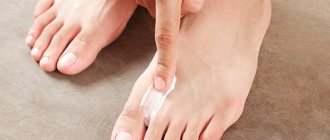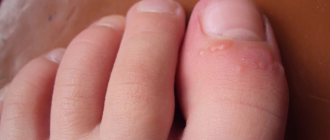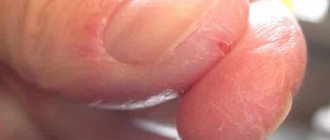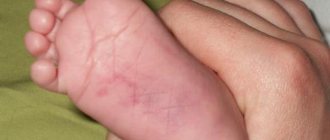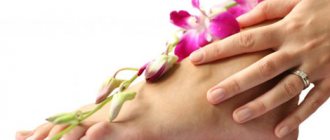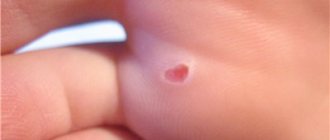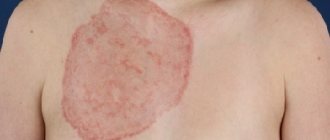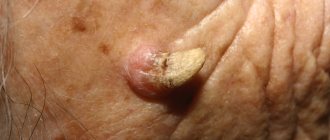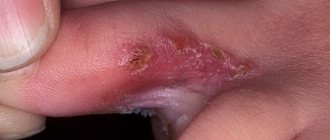The appearance of roughness and redness between the toes or on the feet with further damage to the soles may indicate mycosis. The fungus on the feet (you will find the photo below) is infectious in nature and is transmitted from person to person through common household items. To stop the disease in time, you need to know the causes of its appearance, stages of development and first symptoms.
Forms of fungal development
In medical practice, foot fungus has several forms. The following are distinguished:
- Erased (weakly expressed) . This is the first form of the disease. Slight peeling of the skin appears.
- Squamous-hyperkeratotic . Whitish crusts form. A burning sensation occurs.
- Intertriginous . The affected area swells and turns red. Deep bleeding cracks appear.
- Dyshidrotic . Characterized by the appearance of a large number of bubbles.
In some cases, mycosis of the feet causes more than just cracks. As the fungal infection progresses, small blisters filled with cloudy or transparent contents may appear. With this pathology, the dermis begins to turn red and swell. Over time, the bubbles burst and depressions appear in their place. The ulcers are painful and take a very long time to heal. Scars do not occur with this phenomenon.
In the case of the erased form, the state of the epidermis does not change too much. In the case of a chronic course, the dermis comes off only in partial areas. The most obvious symptoms are peeling and hardening of the epidermis. Little by little, the dermis becomes very rough and acquires a yellowish tint. Over time, mycosis can spread to the thigh, lower leg and buttocks.
Stages and their manifestations
Damage to the feet by microorganisms of pathogenic flora has several stages or clinical forms of its development on the skin:
- erased or initial stage;
- interdigital infection;
- squamous-hyperkeratotic form;
- dyshidrotic stage (wet fungus).
Each form has specific symptoms. Below we will consider in more detail the forms and manifestations of the disease.
initial stage
A fungal infection may not manifest itself for a long time. Minor changes in the condition of the skin of the legs do not cause much discomfort. It all starts with a slight peeling of the epidermis. Redness of the affected areas appears. In addition, burning or itching of the skin occurs periodically.
Monitor your feet carefully and start treatment promptly
Important!
Smoothed signs can develop over several years. The impetus for their active development can be a decrease in immune strength or a violation of hygiene rules.
Interdigital form
Skin lesions between the fingers begin with the thumb, gradually spreading to all phalanges.
The interdigital form of the fungus begins with the thumb and quickly spreads to the rest
Signs of the disease:
- the appearance of small cracks or ulcers in the interdigital area;
- formation of roughness (floury exfoliation);
- mild itching in the affected area.
In the second stage of the disease, the feet and heels look healthy, mainly the epidermis of the fingers suffers.
How does the squamous-hyperkeratotic stage manifest?
At this stage, the skin of the foot undergoes complete changes. Dead skin cells cover the entire sole, including the heel, where the skin becomes rough and cracks over time.
With hyperkeratosis, heel fungus begins to develop. Calloused growths turn into deep cracks, which is accompanied by pain and burning. The sole is covered with large plaques, as if it is in a footprint. The disease is also called moccasin foot.
Read: How to cure foot fungus: pharmacy and folk remedies
Squamosis often affects the nails. The plates begin to darken, thicken, peel off and collapse.
If left untreated, nail fungus (onychomycosis) will completely destroy the nail and its bed.
Dyshidrotic stage
The appearance of blistering formations on the feet indicates advanced disease.
Main symptoms:
- formation of blisters with cloudy liquid;
- the appearance of ulcers after the destruction of the vesicles;
- development of erosion processes;
- watery discharge from ulcerative formations.
Often open wounds get infected, which aggravates the course of the fungal disease. The pathology is difficult to diagnose correctly, as concomitant infections make it similar to eczema or psoriasis.
What each stage looks like can be seen in the photo, which shows the condition of the feet and the development of the fungus.
You can learn more about the dyshidrotic form of foot fungus in this article.
Causes
The main reasons why skin fungus starts on the legs are:
- staying in public places with a humid environment such as swimming pools or saunas;
- excessive sweating;
- intrafamily infection, in the case of a sick relative;
- persistent ulcers and wounds on the skin;
- shoes that are too tight or of poor quality;
- failure to comply with personal hygiene rules.
There are other factors and reasons why foot fungus appears. These include:
- walking barefoot on the grass;
- hypovitaminosis;
- dysbacteriosis;
- phlebeurysm;
- prolonged use of antibacterial drugs;
- pathologies of lymphatic vessels and capillaries;
- local hypothermia;
- psychosomatic disorders;
- staying in unsanitary conditions;
- overweight;
- unhealthy way of life;
- diabetes;
- gestation period;
- flat feet and consequences of dislocations;
- decreased blood circulation in the lower extremities.
Important! Whatever the cause of the disease, it is necessary to begin timely, competent treatment.
Features of mycosis of the feet caused by Trichophyton interdigitale
Trichophyton mentagrophytes var. interdigitale affects the feet in 10 - 30% of cases. Features of the disease:
- With mycosis, only the skin of the feet and rarely the nails on the 1st and 5th toes are affected.
- Most often, the disease occurs with a pronounced inflammatory component and the development of allergic reactions in the form of a rash on the skin of the extremities, trunk and face.
The disease begins acutely with damage to the interdigital folds, where maceration of the skin is noted. Blisters and blisters appear on the skin of the feet, the contents of which quickly suppurate due to the addition of bacterial flora. The foot swells, body temperature rises, an allergic rash appears on the skin of the lower and upper extremities, torso and face, and the inguinal lymph nodes become enlarged. The general picture of foot damage resembles eczema.
Rice. 18. Foot fungus caused by Trichophyton mentagrophytes var. interdigitale.
How is the disease diagnosed?
In order to identify foot skin fungus, it is enough to simply examine the epidermis of the feet, nail plates and interdigital parts. Typical signs help confirm the presence of the disease. To find out which fungus is the causative agent, a scraping is taken from the affected nail plate.
This scraping is sent to the laboratory for analysis. Bacteriological culture helps to very accurately identify the irritant. Typically, such results are ready within a week after the test. Once the results are received, the doctor will be able to tell you how to cure the fungus.
Description of the pathology
A common infectious disease. It affects men and women equally, regardless of age. It is known that every fourth person on Earth is diagnosed with a fungal infection of the skin of the lower extremities. The nature is different - from a decrease in protective forces to damage to the nail plate.
First, the fungus appears on the big toes, in the interdigital folds. Looks like peeling. Later, red areas covered with blisters appear. Kerotin in nails is a breeding ground for microbes.
Methods of infection
Visitors to public establishments - bathhouses, saunas, swimming pools, water parks - who do not follow hygiene rules can find out what fungus is. Other sources:
- trying on shoes on bare feet;
- bed linen in hotels, hospitals, outpatient clinics;
- visiting the beach area.
For risk factors to lead to the development of a disease, one or more of the following circumstances must occur:
- weakening of protective forces;
- some diseases;
- violation of personal hygiene rules;
- excessive physical activity leading to increased sweating;
- wearing shoes that don’t fit, or clothes made of synthetic fabrics;
- hormonal imbalance in women, metabolism;
- frequent contacts with substances of a chemical nature.
Important! The sick person becomes dangerous to others after the appearance of external manifestations of mycosis of the feet. Skin flakes contain a colony of spores.
Treatment
Treatment for fungus on the toes can only begin after an accurate diagnosis has been made. Only your doctor can tell you how to get rid of the fungus. It is important to remember that the cure must be comprehensive. It could be:
- local using ointments, creams and gels;
- systemic with the use of tablets, immunostimulants and various vitamin complexes;
- folk remedies such as baths, lotions, homemade ointments and creams.
Whatever the reason, the doctor will tell you how to treat it after examination. You should not resort to self-medication.
Local treatment of the disease
Local therapy is effective in the first stage of the disease, when the infection affects the dermis between the fingers. Local medications are actively used for parallel nail damage.
Only a dermatologist can prescribe a suitable remedy. Self-medication is contraindicated, since the drugs have a lot of side effects. This can cause great harm to health.
When the folds between the fingers become infected, it is recommended to use creams and ointments. The dermis in this part is very delicate, so any careless actions can easily injure it. This will cause the infection to spread.
Apply a thin layer of product over cracks. When treating the dermis, you should apply the medicine not only to the infected areas, but also 2-3 cm around. This will help get rid of fungal elements on healthy dermis.
In what form to buy the drugs depends on what the fungus looks like. For husking and dryness, it is recommended to purchase ointment. She penetrates deep inside. Effective in the fight against fungus that has become chronic. The ointment is always applied under the bandage. In this case, the active components penetrate even deeper.
Methods for treating fungus with homemade products
- Garlic.
You need to cut off half a clove of garlic, roll it in salt and rub it on problem areas of the skin. Another option for using garlic is to grind the clove into a pulp and make a compress from it on the affected areas or simply rub them with the mixture.
- Onion.
Grind the onion into a paste, then spread it on the sore spots on the surface of the skin. If there are wounds or burst blisters on the skin, you can add Vaseline to the onion mixture (proportion one to one). Squeezed onion juice is also used to treat infection. You need to wipe the infected areas of the skin with this liquid.
- Egg.
To prepare the medicine, you need to pour vinegar over a raw whole egg and leave it in a dark place to infuse until the shell dissolves. Next, you need to get rid of the film, and add butter (1 teaspoon) to the resulting mixture of yolk, white and vinegar.
The resulting mass must be thoroughly mixed to the consistency of an ointment. Apply the ointment to clean, steamed feet, wrap with cling film and gauze. The ointment must be stored in the refrigerator.
- Natural ground coffee.
This is another effective remedy in the fight against toe fungus. Before going to bed, it is recommended to take baths of strong brewed ground coffee. Such procedures will help get rid of unpleasant or painful sensations and cure irritations.
- Vinegar.
Apply wine vinegar to the affected areas and sit until the vinegar dries itself; there is no need to rinse off with water.
- Apple vinegar.
In combination with sea salt, apple cider vinegar will help get rid of the annoying disease. To do this, you need to prepare a bath, which includes: 100 grams of sea salt, 4 tablespoons of vinegar and 5 liters of water. By repeating such baths every day, you can overcome the disease.
- Baking soda.
You need to wet the soda with water until it becomes a thin paste, which should be applied to the fungus-affected areas for 20 minutes, then rinse your feet with warm water, wipe and apply baby powder.
In addition, soda can be used in the form of cool baths. To do this, you need to mix one tablespoon of baking soda and table salt and dilute it all in water. It is recommended to do such baths before bedtime, and then rinse off the solution with clean water.
Possible complications
Toe fungus is dangerous to health because it can easily spread to healthy areas of the skin. Incompetent treatment or an incompletely cured illness can attract other diseases. The consequences may be as follows:
- hips, abdomen, buttocks and limbs are affected;
- pain in the feet when moving and at rest;
- mycosis of the thumb very often causes the progression of diabetes mellitus;
- gangrene and bone infection begins;
- hypersensitivity to various types of fungi.
If foot fungus is left untreated for too long, the infection spreads throughout the body and affects the internal organs.
Types of foot fungus
There are many varieties of fungus.
Trichophyton interdigitale - interdigital form of fungus
The skin of the feet is most often affected by the following types:
- red trichophyton injures the feet and heels;
- trichophyton interdigitale spreads to the interdigital area, and in advanced cases affects the feet, skin of the big toe and epidermis on the little finger;
- Trichophyton mentagrophytes is a type of fungal infection that develops in the skin of the human body (armpits, inguinal folds);
- Candida fungus - the infection causes candidiasis of the mucous membranes and genital organs, but lesions of the skin of the feet also occur.
Read: The skin between the toes is peeling - what to do?
Dermatophytes can cause local damage to the skin. The name of this disease is epidermophytosis - a very contagious pathology that intensively develops on the human body.
The fungus is dangerous due to its consequences - start treatment immediately
The effectiveness of its treatment depends on the type of fungal infection. Therefore, it is important to consult a doctor in time to diagnose the causative agent of the disease.
Prevention
Absolutely every doctor will be able to confirm the fact that preventing toe fungus is much easier than treating it later. Especially if mycosis of the interdigital zone progresses. The resulting symptoms are extremely unpleasant. It takes a very long time to treat the disease and after treatment you need to follow some rules:
- It is important to adhere to the rules of personal hygiene. It is prohibited to use other people's hygiene items.
- Always wear slippers in swimming pools and saunas and never walk barefoot. After washing your feet, wipe dry and treat with lemon juice.
- Pay due attention to the condition of the dermis of the legs.
- Moisturize the skin using special cosmetic products. This will help avoid cracks.
- Monitor your health and prevent a decrease in immunity.
- Treat the inside of shoes with vinegar.
- Wear new socks every day and purchase only from natural materials.
- Be sure to make foot baths at home.
Fungal spores are killed when exposed to chlorine. Therefore, it is recommended to regularly treat the premises. Fungi are also afraid of high temperatures.
From all that has been said, we can conclude that foot fungus is an extremely dangerous disease. The consequences of the disease can be extremely negative for human health. You should not self-medicate so as not to cause complications.
Main symptoms, how do they manifest themselves?
Despite the fact that at the initial stage of development the disease does not have a pronounced clinical picture, as the pathology progresses, an infected person may notice the appearance of such unpleasant symptoms as:
- small cracks in the areas between the fingers;
- slight redness and irritation of the skin;
- coarsening of the upper layer of the epidermis;
- itching and burning;
- discomfort in the affected areas;
- peeling of the skin;
- skin peeling;
- formation of compactions in different areas of the foot;
- unpleasant odor;
- swelling;
- tightness and dryness of the skin;
- formation of small watery blisters.
Important!
At an advanced stage, an infected patient may experience an increase in body temperature.
Rapid infection
Ringworm of the feet is easily transmitted in public places from a sick person to a healthy person. Infection occurs through contact surfaces: floors, household items, personal hygiene items, other people's shoes. The fungus is transmitted by direct contact; it multiplies very quickly, which is why it is so easy to become infected. Situations of fungus transmission in hairdressing salons through tools during a pedicure, as well as towels, cannot be ruled out. The disease affects the skin of the feet. It is especially common among men, as they spend most of their time in closed shoes. Frequent visits to gyms, baths, military service, where you do not always have to wear your shoe size - all this creates favorable conditions for the proliferation of pathogenic bacteria. Pathogenic fungi benefit from an unventilated area of the room for reproduction. The spread of pathogenic flora occurs very quickly. The place where the fungus predominates is the toes and interdigital spaces. Saunas and baths are characterized by high humidity and high temperature, which is ideal for the development of pathogenic microflora.
Infection with fungus can be direct or indirect. You can become infected directly through direct contact with a sick person. Indirect contamination includes the use of objects that were used by a sick person.
Diagnosis of fungal foot disease
The doctor conducts a detailed examination of the foot and asks for complaints. Skin samples are taken from the patient to be tested for fungus. A skin fragment is obtained from a minor, specially made scratch on the foot. The nail for analysis is cut off from the area infected with the fungus. The presence of mycosis is determined by special tests. To identify the type of fungus, it is cultivated, that is, it is grown. In rare cases, with an advanced stage of the disease, the patient may be prescribed a biopsy. In this case, the prepared material is studied under a microscope.
